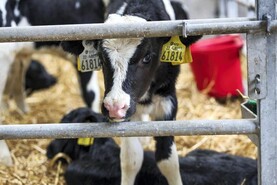Neosporosis is a parasitic condition caused by the protozoan parasite Neospora caninum. It is one of the top three causes of late-term abortion in cows in Ireland, together with salmonellosis and leptospirosis.
As the name suggests, this parasite has a strong connection to canines. The dog or fox are the final hosts of this parasite and pass infective oocysts (protozoan eggs) in their faeces. Cattle become infected following ingestion of feed contaminated by dog or fox droppings (Figure 1). The parasites then migrate from the gut, through the blood, and settle out in the reproductive tract with resulting clinical signs.
While ingestion of contaminated feed or water is the main method of transmission, Neospora can also be transmitted vertically (from cow to calf) both inutero (during gestation) and via milk. There is also evidence that some horizontal transmission (from cow to cow) occurs in herds, mainly via infective vaginal discharges and placentae.
Symptoms
Cows/heifers can abort atany stage of gestation from three months on, but most abortions occur from five to six months (Figure 2). Abortion is not generally associated with retained placenta or sickness in the cow.
A characteristic of Neospora infection, however, is the much higher incidence of repeat abortions in cows exposed to the disease. Some cows may abort several times due to chronic Neospora infection.
As well as abortion, Neospora can cause mummification (the death of the foetus which is not aborted but shrinks down into a hard, non-specific mass), and the birth of weak, light calves, often with neurological deficits. Calves may have difficulty standing and sucking, as well as having poor reflexes and exophthalmia (protruding eyes). Not all foetuses are harmed, however, with the birth of normal calves from antibody positive cows.
Diagnosis
Aborted foetuses and the accompanying placenta should be submitted to the regional veterinary laboratory for post-mortem, if at all possible. In fresh cases, lesions will be found on histopathology of the heart and brain. Blood testing of cows post-abortion should also be carried out and antibodies to Neospora will indicate that the cow has been exposed to this parasite, making it one of the most likely causes of the abortion.
Bulk milk antibody testing can also be used to screen a dairy herd for evidence of exposure, with subsequent blood testing to identify serologically positive animals.
Treatment
There is no effective treatment in cattle.
Control/prevention
Control of Neospora-induced abortion in cattle depends on protecting feed and water from contamination by the faeces of dogs or foxes. Doors and barriers around cattle feed should be kept closed as much as possible and dogs should not be allowed to eat aborted foetuses or placentae Figure 3).
Dogs should be wormed regularly with effective wormers such as praziquantel. There is a strong argument for the culling of seropositive (antibody positive) animals from the herd. Seropositive animals have been shown to suffer a higher risk of abortion than seronegative animals in the herd.
*This article previously appeared in the Irish Farmers Journal on 16 July 2011 as part of a series on animal health.






 This is a subscriber-only article
This is a subscriber-only article













SHARING OPTIONS: